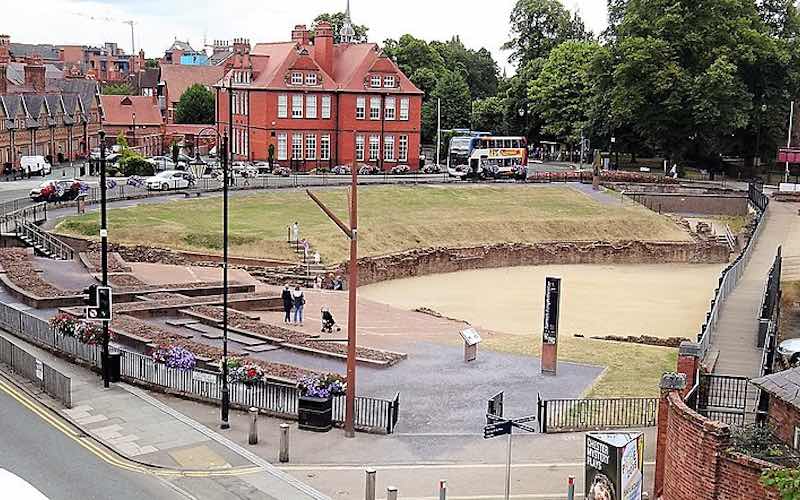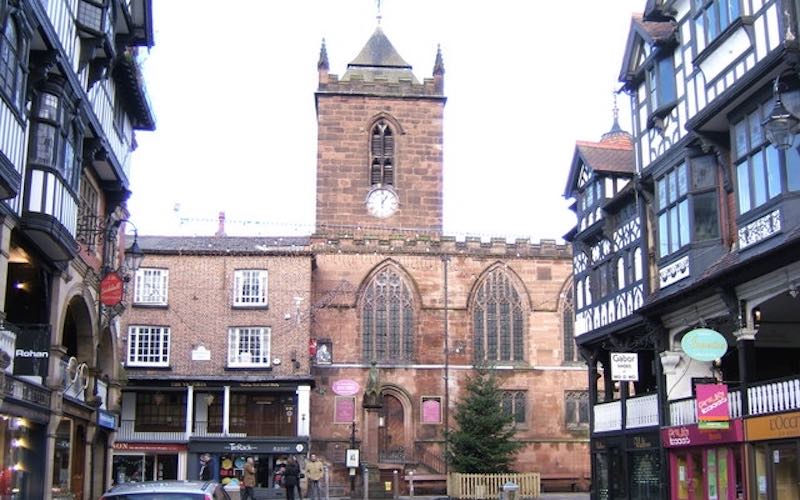There are so many free things to do in Chester including walking the Roman Walls, visiting the amphitheatre and Chester Rows (old houses). Chester is one of my favourite UK cities because it is so full of history. And the great thing is that you don’t need to go with a lot of money in your pocket, because a lot of sites are outdoors and free — just pick a day with decent weather if you can (hard in the UK I know!).
Chester is a Northern UK city and can get quite rainy at times! Check the weather and always take comfortable footwear such as trainers or walking boots. Have a raincoat with you (and possibly an umbrella!) If you have a good weather day it is a nice idea to take a picnic as there are lots of lovely places to picnic in the city centre and along the river Dee.
Here are some of the best things to do in Chester….
Roman Amphitheatre
One of the best free things to do in Chester is to see the Roman Amphitheatre. The Chester Roman Amphitheatre, designated as a Grade I listed structure and managed by English Heritage, was discovered in 1999 and is the largest Roman site discovered in the United Kingdom. It’s nice to walk about the amphitheatre, there’s lots of interesting things to see and it transports you back in time. If you’re planning a trip to Chester, it’s certainly worth checking out. The excavated parts of the amphitheatre are surrounded by a level pavement and footpath with a clear view down to the site. Only a few steps go to the main theatre area. The amphitheatre welcomes dogs and admission is free. It is open every day during daylight hours throughout the year.

Walk the City Walls
The city walls are the oldest, longest, and most complete in the United Kingdom, with parts dating back nearly 2000 years. This is one of the most popular free things to do in Chester. Chester is the only city in the United Kingdom where the entire circuit of its old defence walls has been preserved. Walking the entire circuit provides breath-taking vistas of the city and a fascinating insight into Chester’s long history. Each of the four main gateways — Northgate, Eastgate, Watergate, and Bridgegate — provides entrance to the walls. The steps to the right of the Northgate will stay available, allowing pedestrians to access the wall at that point if they wish to go clockwise. All year long, there is free unlimited access.
Chester Cathedral
Chester Cathedral is a lively community of worship, a cultural hub, and a centre of musical excellence that welcomes visitors with a unique blend of mediaeval and modern heritage. The cathedral is free to see, however donations are appreciated. Chester Cathedral has a rich and varied history, as well as a dynamic and exciting future, as you will see. Parts of the ancient church, which were built in the Romanesque or Norman style, can still be seen today. This church was then reconstructed in the Gothic style from 1250 onwards, a process that took roughly 275 years and culminated in the magnificent structure we see today. It’s free to enter Chester Cathedral, but donations are welcome.
Chester Rows
The Rows are a unique collection of two-story, 13th century structures with half-timber bay windows and continuous balconies that stretch along Watergate Street, Northgate Street, Eastgate Street, and Bridge Street. It’s an eclectic mix of Medieval, Georgian, and Victorian architecture that leaves first-timers in awe. The architecture of these structures is directly influenced by how they have been used over time; thus, you can see the history in them. They are exquisite and add significantly to Chester’s charm and beauty. Even if shopping isn’t your thing, Discover the Rows, a walking, and audio tour, allows you to see the Rows while learning about the area’s history and architecture. This area of the city is worth a visit to observe the living history in the well-preserved architecture.
Eastgate Clock

After Big Ben, the Eastgate clock, one of Chester’s most recognisable attractions, is the second most photographed clock in the UK. For everyone visiting Chester, the Eastgate Clock is a must-see attraction. The current gateway, a three-arched sandstone structure dating from 1768, carries the promenade that runs beside Chester’s city walls. The current gate was built in Georgian times to enable carriages past, even though the old gate was Roman. The clock was not added until the Victorian era, in 1988, to commemorate Queen Victoria’s diamond jubilee.
Grosvenor Park
Grosvenor Park is a 20-acre green flag award-winning park that dates to 1867. It is Chester’s major ornamental park, with a layout designed by Edward Kemp. It is immensely popular among both city inhabitants and visitors. It is one of the greatest examples of Victorian parks in the UK, located just outside the city walls and overlooking the river, Dee. The park is notable for its formal avenues lined with trees, monuments, huge sweeping lawns bordered by attractive shrub beds and display bedding. The bedding arrangements are planted twice a year to offer a beautiful and colourful display in the Spring and Summer. The popular miniature railway and a nice play area make the park a great spot to visit with the kids. Open weekends, public holidays, and school holidays from February to November, and weekends from December to January. Summer hours are 10.30am to 5pm. Winter hours are 11am to 4pm. The play area is in a fully accessible area, allowing everyone to have fun and explore. Andrew Small, a local artist, created it out of a variety of natural materials.
Grosvenor Museum
The Grosvenor Museum features exhibits on Chester’s history, art, and silver heritage, as well as natural history. Visit the Period House, which has rooms from the 17th century to the 1920s, to learn about life during the Roman military occupation. Make sure you visit the shop since it leads to a magnificent ancient mansion that has been through the years. Chester Bus Station is a 10–15-minute walk from the Museum. Walk down Bridge Street from the Cross and turn right onto Grosvenor Street at the traffic lights. On the left side of the road, you’ll find the museum.
Cheshire Military Museum
From the 17th century to the current day, the Cheshire Military Museum in Chester tells the narrative of the Cheshire Soldiers. Follow the adventures of the Cheshire Regiments and their journeys across the globe during several major conflicts. Learn about the wars they fought, what it was like to be a World War One soldier in the trenches and immerse yourself in the soldiers’ history. The Cheshire Regiment Archive is also housed at the museum. It is open from 10 a.m. to 5 p.m. daily, with the last admission at 4 p.m. During the Christmas season, the Museum is closed for two weeks.
Chester Town Hall
Chester Town Hall is in the heart of the city on Northgate Street. The construction of the grey and red sandstone gothic style edifice, with a 160-foot tower, took four years and was finally completed in 1869. It is a magnificent and one-of-a-kind grade II listed structure with a stately Council Chamber steeped in history. The Victorian carved stone lobby and arching staircase of the Town Hall provide a stunning setting for your picture. The Market Place entrance provides pedestrian access to the structure.
Countess of Chester Country Park
The Countess of Chester Country Park brings the countryside closer to the city, allowing visitors to stroll around the park’s pathways and take in the natural and serene surroundings. Kestrels soar magnificently above the grasslands, which are home to colourful butterflies like the Common Blue, Peacock, and Red Admiral during the summer. A Greater Spotted Woodpecker or a Sparrowhawk may be seen in the woods. There are a variety of wetland and meadowland ecosystems in the park, as well as woodland parts that are being improved with new planting. Wildflower meadows have been planted at various locations across the park with the cooperation of local schools, visitors, and volunteers. The park conducts regular wildlife surveys, and the number of birds, butterflies, and other insects has increased dramatically since it opened.
Caldy Nature Park
Caldy Nature Park is a small wetlands, woodland, and meadows region near Chester city centre. A round route around the natural area can be taken from the parking lot. The path’s surface is hard and compact, with no gradients exceeding 1:10. There are various benches around the park, as well as other routes, some of which have steps. The free car park is accessible from Caldy Valley Road (A41), where there is a designated disabled parking area, and the car park is available 24 hours a day. There are no snacks or restrooms on site, although there is a grocery café and a public house close.
Godstall Lane
Godstall Lane is a narrow street that connects St Werburgh Street with Eastgate Street Row. Small shops and a couple of bars line the street. Within the City Walls, Godstall Lane is one of only four mediaeval pathways that have survived. The name, which means ‘God’s Place,’ comes from a legend that a hermit lived here in the 12th century. Godstall Lane can be reached via St Werburgh Street, just across from the Cathedral, or by stairs from Eastgate Street, directly across from Browns of Chester. Discover the charms of Godstall Lane as you stroll through the cobblestone streets.
Further Reading on Chester
If you enjoyed this blog on free things to do in Chester, why not read some of my other articles on this fabulous historical city? I absolutely LOVE Mad Hatters Tea rooms and so if your budget can stretch to it I would definitely recommend lunch there. This extensive article on how to spend 24 hours in Chester is also one that you may find helpful.

